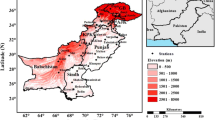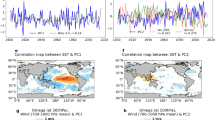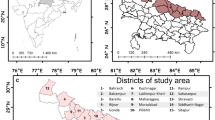Abstract
A long-term (1948 to 2012) trend of precipitation (annual, pre-monsoon, monsoon, and post-monsoon seasons) in Bangladesh was analyzed in different regions using both parametric and nonparametric approaches. Moreover, the possible teleconnections of precipitation (annual and monsoon) variability with El Niño/Southern Oscillation (ENSO) episode and Indian Ocean Dipole (IOD) were investigated using both average and individual (both positive and negative) values of ENSO index and IOD. Our findings suggested that for annual precipitation, a significant increasing monotonic trend was found in whole Bangladesh (4.87 mm/year), its western region (5.82 mm/year) including Rangpur (9.41 mm/year) and Khulna (4.95 mm/year), and Sylhet (10.12 mm/year) and Barisal (6.94 mm/year) from eastern region. In pre-monsoon, only Rangpur (2.88 mm/year) showed significant increasing trend, while in monsoon, whole Bangladesh (3.04 mm/year), Sylhet (7.17 mm/year), and Barisal (6.94 mm/year) showed similar trend. In post-monsoon, there was no significant trend. Our results also revealed that the precipitation (annual or monsoon) of whole Bangladesh and almost all of the spatial regions did not show any significant correlation with ENSO events, whereas the average IOD values showed significant correlation only in monsoon precipitation of western region. The individual positive IODs showed significant correlation in whole Bangladesh, western region, and its two divisions (Rajshahi and Khulna). So, in the context of Bangladesh climate, IOD has the more teleconnection to precipitation than that of ENSO. Our findings indicate that the co-occurrence of ENSO and IOD events may suppress their influence on each other.



Similar content being viewed by others
References
Ahasan MN, Chowdhury MAM, Quadir DA (2010) Variability and trends of summer monsoon rainfall over Bangladesh. J Hydro Meteorol 7(1):79–94
Ahasan MN, Chowdhury MA, and Quadir DA (2008) Few aspects of the flood disaster caused by heavy rainfall over Bangladesh. Proceedings of SAARC Seminar on Application of Weather and Climate Forecasts in the Socio-economic Development and Disaster Mitigation, 05-07 August, 2007, Dhaka, Bangladesh, 79–94
Ahmed M (1997) Rainfall climatology of the Barind area of Bangladesh: a comparison between 1902–74 and 1975–93. J Remote Sens Env 1:55–69
Ahmed ASMS, Munim AA, Begum QN, Chowdhury AM (1996) El Nino southern oscillation and rainfall variation over Bangladesh. Mausam 47(2):157–162
Ajayamohan RS, Rao SA (2008) Indian Ocean dipole modulates the number of extreme rainfall events over India in a warming environment. J Meteo Soc Japan 86:245–252
Allan RJ, Nicholls N, Jones PD, Butterworth IJ (1991) A further extension of the Tahiti Darwin SOI, early SOI results and Darwin pressure. J Clim 4:743–749
Ashok K, Guan Z, Yamagata T (2001) Impact of the Indian Ocean dipole on the relationship between the Indian monsoon rainfall and ENSO. Geophy Res Lett 28:4499–4502
Ashok K, Guan Z, Saji NH, Yamagata T (2004) Individual and combined influences of ENSO and the Indian Ocean dipole on the Indian summer monsoon. J Clim 17:3141–3155
Ashok K, Saji NH (2007) On the impacts of ENSO and Indian Ocean dipole events on sub-regional Indian summer monsoon rainfall. Nat Hazards 42:273–285. doi:10.1007/s11069-006-9091-0
Burn DH, Hag Elnur MA (2002) Detection of hydrologic trends and variability. J Hydrol 255:107–122
Cherchi A, Navarra A (2013) Influence of ENSO and of the Indian Ocean Dipole on the Indian summer monsoon variability. Clim Dyn 41(1):81–103
Chowdhury AM (1994) Bangladesh floods, cyclones and ENSO. Paper presented at the International Conference on Monsoon Variability and Prediction, International Center for Theoretical Physics (ICTP), Italy, 9–13 May
Chowdhury MHK, Pramanik MAH, Quadir DA, Ferdousi N (1997) Study of meteorological parameter related to climate variability in Bangladesh. Atmosphere 3:71–88
Chowdhury MR (2003) The El Nino-Southern Oscillation (ENSO) and seasonal flooding—Bangladesh. Theor Appl Clim 76:105–124
Douglas WW, Wasimi SA, Islam S (2001) The El Niño southern oscillation and long-range forecasting of flows in the Ganges. Int J Clim 21:77–87
Fujinami H, Hatsuzuka D, Yasunari T, Hayashi T, Terao T, Murata F, Kiguchi M, Yamane Y, Matsumoto J, Islam MI, Habib A (2011) Characteristic intraseasonal oscillation of rainfall and its effect on interannual variability over Bangladesh during boreal summer. Int J Clim 31(8):1192–1204
Gan TY, Kwong YT (1992) Identification of warming trends in northern Alberta and southern Northwest Territories by the non-parametric Kendall’s test. In: Kite GW, Harvey KD. (Eds.). Using Hydrometric data to detect and monitor climate change. Proceedings of NHRI workshop No. 8 National Hydrology Research Institute, Saskatoon, SK. 43–56
Gao C, Gemmer M, Zeng X (2010) Projected stream flow in the Huaihe River basin (2010–2100) using artificial neural network. Stochast Environ Res Risk Assess 24:685–697
Gemmer M, Becker S, Jiang T (2004) Observed monthly precipitation trends in China 1951–2002. Theor Appl Clim 77:39–45
Gershunov A, Schneider N, Barnett T (2001) Low-frequency modulation of the ENSO–Indian monsoon rainfall relationship: signal or noise? J Clim 14:2486–2492
Glantz MH, Katz RW, Nicholls N (Eds.) (1991) Teleconnections linking worldwide climate anomalies: scientific basis and societal impact. Cambridge University Press
Han W, Webster P (2002) Forcing mechanisms of sea level interannual variability in the Bay of Bengal. J Phys Ocean 32:216–239
Hasan Z, Akhter S, Islam M (2014) Climate change and trend of rainfall in the south-east part of coastal Bangladesh. Europ J Sci Res 10(2):25–39
Hashizume M, Faruque AS, Terao T, Yunus M, Streatfield K (2011) The Indian Ocean dipole and cholera incidence in Bangladesh: a time-series analysis. Env Health Perspect 119:239–244. doi:10.1289/ehp.1002302
Hashizume M, Armstrong B, Hajat S, Wagatsuma Y, Faruque AS, Hayashi T (2008) The effect of rainfall on the incidence of cholera in Bangladesh. Epidemiology 19:103–110
Hirsch RM, Slack JR, Smith RA (1982) Techniques of trend analysis for monthly water quality data. Water Resour Res 18:107–121
Hong CC, Lu MM, Kanamitsu M (2008) Temporal and spatial characteristics of positive and negative Indian Ocean dipole with and without ENSO. J Geophys Res 113:D08107
Hossain E, Alam SS, Imam KH, Hoque MM (2001) Bangladesh country case study: impacts and response to the 1997–98 El Nino event. In: Glantz MH (ed) Once burned twice shy? vol 1, United Nations University Press., pp 44–50
IPCC 2007b. Climate Change (2007) The Physical Science Basis. Contribution of working group I to the fourth assessment report of the intergovernmental panel on climate change. In: Solomon S, Qin D, Manning M, Chen Z, Marquis M, Averyt KB, Tignor M. & Miller HL. (eds.). Cambridge, Cambridge University Press
Jensen TG (2007) Introduction: special issue on Indian Ocean climate. J Clim 20:2869–2871
Jourdain NC, Taschetto AS, Gupta AS, Ummenhofe CC, Moise AF, Ashok K (2013) The Indo-Australian monsoon and its relationship to ENSO and IOD in reanalysis data and the CMIP3/CMIP5 simulations. Springer-Verlag Berlin Heidelberg. Climate Dynamics 41: 3073–3102. DOI 10.1007/s00382-013-1676-1
Kane RP (1998) Extremes of the ENSO phenomenon and Indian summer monsoon rainfall. Int J Climt 18:775–791
Karmakar S, Khatun A (2000) Variability and probabilistic estimates of rainfall extremes in Bangladesh during the southwest monsoon season. Mausam 46(1):47–56
Khan TMA, Singh OP, Rahman MS (2000) Recent sea level and sea surface temperature trends along the Bangladesh Coast in relation to the frequency of intense cyclones. Mar Geod 23(2):103–116
KinterJL III, Miyakoda Y, Yang S (2002) Recent change in the connection from Asian monsoon to ENSO. J Clim 15:1203–1215
Kendall MG (1975) Rank correlation measures. Charles Griffin, London 1:25–55
Können GP, Jones PD, Kaltofen MH, Allan RJ (1998) Pre-1866 extensions of the southern oscillation index using early Indonesian and Tahitian meteorological readings. J Clim 11:2325–2339
Kripalini RH, Inamdar S, Sontakke NA (1996) Rainfall variability over Bangladesh and Nepal: comparison and connections with features over India. Int J Clim 16:689–703
Kumar KK, Soman MK, Kumar RK (1995) Seasonal forecasting of Indian summer monsoon rainfall: a review. Weather 50(12):449–467
Kumar KK, Rajagopalan B, Cane MA (1999) On the weakening relationship between the Indian monsoon and ENSO. Science 284:2156–2159
Mann HB (1945) Non-parametric tests against trend. Econometrica, New York 13:245–259
Mannan MA, Karmakar S (2008) Proceedings of SAARC Seminar on Application of Weather and Climate Forecasts in the Socio-economic Development and Disaster Mitigation, 05–07 August, 2007, Dhaka, Bangladesh 1: 95–115
May W (2004) Simulation of the variability and extremes of daily rainfall during the Indian summer monsoon for present and future times in a global time-slice experiment. Clim Dyn 22(2–3):183–204
Nahrin Z, Munim AA, Quadir DABQN (1998) Studies of periodicities of rainfall over Bangladesh. J Remote Sens Env 1:43–54
Palmer TN, Raisanen J (2002) Quantifying the risk of extreme seasonal precipitation events in a changing climate. Nature 415(6871):512–514
Parthasarathy B, Pant GB (1985) Seasonal relationships between Indian summer monsoon rainfall and the southern oscillation. Int J Clim 5:369–378
Rao AS, Behera SK, Masumoto Y, Yamagata T (2002) Interannual subsurface variability in the tropical Indian Ocean with a special emphasis on the Indian Ocean Dipole. Deep Sea Res II 49:1549–1572
Rashid HR (1991) Geography of Bangladesh. University Press Ltd., Dhaka, Bangladesh
RasmussonEM CTH (1983) The relationship between eastern equatorial Pacific sea surface temperatures & rainfall over India and Sri Lanka. Mon Weather Rev 111:517–528
RasmussonEG CTH (1982) Variations in tropical sea surface temperature and surface wind fields associated with the Southern Oscillation/El Niño. Mon Weather Rev 110:354–384
Ropelewski CF, Halpert M (1996) Quantifying Southern Oscillation–precipitation relationship. J Clim 9(5):1043–1059
Ropelewski CF, Jones PD (1987) An extension of the Tahiti–Darwin Southern Oscillation index. Mon Weather Rev 115:2161–2165
Roy MK, Rahaman S, Paul JC (1987) Regional variations in the trends and periodicities of annual rainfall over Bangladesh. Int J Sci Res Publ 3(8):2250–3153
Saji NH, Yamagata T (2003) Possible impacts of Indian Ocean dipole mode events on global climate. Clim Res 25:151–169
Saji NH, Yamagata T (2001) A view of the tropical Indian Ocean climate system from the vantage point of Dipole Mode events. J Clim 1:23–45
Saji NH, GoswamiBN VPN, Yamagata T (1999) A dipole mode in the tropical Indian Ocean. Nature 401:360–363
Salas JD (1993) Analysis and modeling of hydrologic time series. In: Maidment D (ed) Handbook of hydrology, McGraw-Hill, 1:72
Sen PK (1968) Estimates of the regression coefficient based on Kendall’s tau. J Am Stat Assoc 63:1379–1389
Shahid S (2009) Rainfall variability and the trends of wet and dry periods in Bangladesh. Int J Climat 30(15):2299–2313. doi:10.1002/joc.2053
Shahid S (2010) Trends in extreme rainfall events of Bangladesh. Theor Appl Climatol 104:489–499
Shukla J, Paolino DA (1983) The southern oscillation and long range forecasting of the summer monsoon rainfall over India. Mon Weather Rev 115:695–703
Singh OP, Khan TMA, Rahman MS, Salahuddin M (2000) Summer monsoon rainfall over Bangladesh in relation to multivariate ENSO index. Mausam 51:255–260
SAARC Meteorological Research Centre (SMRC) (2006) Rainfall over SAARC region with special focus on teleconnections and long range forecasting of Bangladesh monsoon rainfall, monsoon forecasting with a limited area numerical weather prediction system. SMRC Report No-19
Sneyer R (1990) On the statistical analysis of series of observations. Technical Note no. 143, WMO No. 415, World Meteorological Organization
Torrence C, Webster PJ (1999) Inter decadal changes in the ENSO-Monsoon system. J Clim 12:2679–2690
Trenberth KE (1997) The definition of El Niño. Bull Am Meteorol Soc 78:2771–2777
Varikoden H, Preethi B (2013) Wet and dry years of Indian summer monsoon and its relation with Indo-Pacific sea surface temperatures. Int J Climat 33(7):1761–1771
Walker GT, Bliss EW (1932) World weather V. Memor Meteo Soc 4:53–84
Wahiduzzaman M (2012) ENSO connection with monsoon rainfall over Bangladesh. Int J of Appl Sci Eng Res 1(1):26–38
Whitaker DW, Wasimi SA, Islam S (2001) The El Nino Southern Oscillation and long range forecasting of flows in the Ganges. Int J of Clim 21:77–87
Webster PJ, Moore AM, Loschnigg JP, Leben RR (1999) The great Indian Ocean warming of 1997–98: evidence of coupled oceanic-atmospheric instabilities. Nature 401:356–360
World Bank (2013) Turn down the heat: climate extremes, regional impacts, and the case for resilience. A report for the World Bank by the Potsdam Institute for Climate Impact Research and Climate Analytics. Washington DC: World Bank
Zubair L, Ropelewski CF (2006) The strengthening relationship between ENSO and northeast monsoon rainfall over Sri Lanka and southern India. J Clim 19:1567–1575
Acknowledgments
The authors express their profound gratitude to Bangladesh Meteorological Department (BMD) for its generous support by providing the essential data. The anonymous reviewer is also thanked for his/her valuable comments which intensively develop manuscript. Annesa Research Center (ARC) is also acknowledged for its kind assistance by delivering the facilities for the fulfillment of the research.
Author information
Authors and Affiliations
Corresponding author
Rights and permissions
About this article
Cite this article
Ahmed, M.K., Alam, M.S., Yousuf, A.H.M. et al. A long-term trend in precipitation of different spatial regions of Bangladesh and its teleconnections with El Niño/Southern Oscillation and Indian Ocean Dipole. Theor Appl Climatol 129, 473–486 (2017). https://doi.org/10.1007/s00704-016-1765-2
Received:
Accepted:
Published:
Issue Date:
DOI: https://doi.org/10.1007/s00704-016-1765-2




